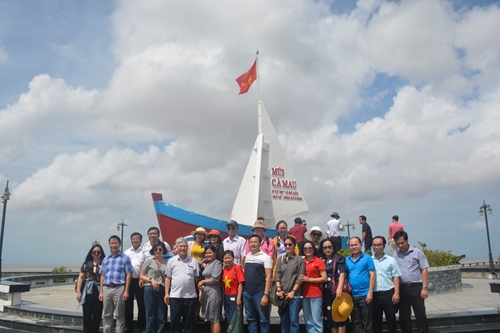A close look at Ca Mau
We returned to Ca Mau cape, the Southernmost land on the mainland of the country as the Tet 2023 was just around the corner. The flat road from Ca Mau city to the cape made the distance seem shorter.
Back to the past 13 years ago, on the occasion of the Tet 2010, I followed a delegation of the Party’s Platform and Political Report Subcommittee of the 11th Party Congress to tour Ca Mau province. The delegation was headed by then Chairman of the National Assembly Nguyen Phu Trong (now Party General Secretary).
At that time, there was no road to Ca Mau cape; the delegation had to go by motorboat. On the way to the cape, we heard many stories about this land. An official of the Information and Education Department of the Ca Mau provincial Party Committee said that Ca Mau is the only province in Vietnam that has three sides bordering the sea.
Ca Mau in Khmer means “black water.” Black is the typical color of rivers in this region due to the immense fall of Melaleuca leaves, which change the color of the water. Ca Mau is a province of wetlands, with many wild and strabismus bushes.
    |
 |
|
Visitors taking photo in Ca Mau |
Visiting the people in Dat Mui commune (Ngoc Dien district), Mr. Nguyen Phu Trong shared difficulties with the locals and acknowledged their recommendations on economic restructuring and developing agriculture as well as infrastructure. These were also common difficulties facing many localities in Ca Mau province. Speaking at the meeting with officials and people of Dat Mui commune; officers and soldiers of Border Post 680 (Ca Mau provincial Border Guard Command) and the Standing Board of the Ca Mau provincial Party Committee, Mr. Nguyen Phu Trong made recommendations to the province’s poverty reduction and sustainable enrichment, such as developing specialty goods that Ca Mau has strengths, promoting community tourism, linking households and businesses.
Thirteen years later, Mr. Nguyen Phu Trong’s recommendations in the past came true in Ca Mau.
Thirteen years ago, there were few tourists in Ca Mau, but now there are a lot. Electric trams that transport tourists to the cape are always full, as the province has many beautiful landscapes.
Many other localities in the province have been invested in roadway infrastructure, improving the waterway system, so traveling is now more convenient.
Enriching from difficult land
We were really surprised by the way people here do business. In Thoi Binh district, the locals took initiatives to combine shrimp farming with specialty rice cultivation (ST24, ST25). Shrimp and rice are both very clean, organic products that are sold at high prices.
In Tran Van Thoi district, there is a factory producing dried bananas, Bay Hoang, taking advantage of the local source of Siamese bananas so as to successfully develop dried Siamese bananas and be recognized as a four-star standard of the One Commune-One Product (OCOP) program, becoming one of the local unique products. Meanwhile, U Minh and Ngoc Hien districts develop specialty crab farming and an ecotourism model.
We also came across green fields of Typha orientalis on this occasion. People here always put it in salty water to make specialties.
Although U Minh used to be a poor locality in Ca Mau province, in recent decades, with new mechanisms and policies, it has exploited potential of its natural conditions to bring about economic efficiency. The local authorities have also encouraged the locals to join afforestation using the new method, gaining high benefits.
Example in poverty reduction
More than ten years ago, Ca Mau was one of the provinces with the highest proportion of hungry and poor households in Vietnam. Reportedly, in the 2011-2015 period, there were 35,451 poor families in the whole province, accounting for 12.14%. However, it has surmounted difficulties to become a leading locality in the movement of hunger eradication and poverty reduction in the Mekong Delta region in the 2016-2020 period. Furthermore, the percentage of poor households in the province decreased from 9.94% to 2.52%, an average decrease of 1.9% per year, reaching and exceeding the set target.
At the beginning of the 2022–2025 period, Ca Mau only had 9,569 poor households, accounting for 3.12%; the rate of near-poor families was 2.26%. The province is striving to reduce the annual rate of poor households by at least 0.5%, by the end of 2025, to no more than 1%.
Even though facing harsh weather conditions in 2022, the locals still made achievements in many fields. Back in Ca Mau, I had a chance to visit some billionaire farmer households. Reportedly, in the past five years, the province has had more than 366,900 farming households achieving the title of “good farmer” in production and business at all levels, of which more than 2,000 households have an annual income of VND 1 billion and above. Local farmers have successfully implemented high-tech shrimp farming, industrial shrimp farming, and safe vegetable growing in net houses, among others.
Prior to the Tet 2023, Ca Mau province seems to be changing its look with beautiful blue sky above and new crops, new construction sites under it. The rise of Ca Mau is symbolized in the image of the sail being stretched in the wind, bringing the mighty Ca Mau's bow straight to the sea.
Written by Do Phu Tho
Translated by Minh Anh